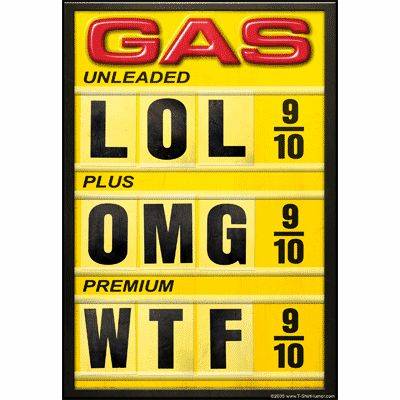Lower Gas Prices Don't Inspire More Driving
Apologists for business-as-usual in the car game often took to blaming unnaturally high gas prices for last year’s trends towards smaller car sales and fewer vehicle miles traveled. When gas prices go back down, went the argument, Americans will go right back to buying thirsty SUVs and Crossovers and driving more miles. Not true, it seems. The New York Times reports that vehicle miles traveled (VMT) has declined for 14 months in a row now, despite the fact that gas prices are now hovering at about half of their peak levels from last June. “When the decline in American driving was first identified in late 2007, fuel prices were beginning to increase. The prevailing wisdom at the time was that the drop was due to increased fuel prices,” says Doug Hecox of the Federal Highway Administration which monitors traffic on America’s roads. The FHA estimates that VMT has declined by 115 billion miles in the period between November 2007 and December 2008.
Economic decline is being blamed for the driving decline as recession was likely setting in around the same time that gas prices started to increase. The American Public Transportation Association shows a steady increase in public transportation ridership since the beginning of 2008, particularly in the first three quarters of 2008, when 3.42 to 6.52 percent more Americans took the bus. Ridership actually declined in the fourth quarter of 08 as job loss took its toll on public transportation riders, 58 percent of whom depend on the service to get to work. And despite having had one non-causal explanation for lower driving (high fuel prices) levels debunked, the FHA is running with the latest non-causal explanation predicting that Americans will rush back to their cars as soon as the recession is “over.” “When people have a job to go to,” says Hecox, “the decline in American driving may fade into the nation’s rear-view mirror.” Unless it doesn’t. In which case a new easily-understood reason is sure to emerge. Meanwhile, what happens if people get used to not depending on cars?
More by Edward Niedermeyer
Latest Car Reviews
Read moreLatest Product Reviews
Read moreRecent Comments
- Lichtronamo Watch as the non-us based automakers shift more production to Mexico in the future.
- 28-Cars-Later " Electrek recently dug around in Tesla’s online parts catalog and found that the windshield costs a whopping $1,900 to replace.To be fair, that’s around what a Mercedes S-Class or Rivian windshield costs, but the Tesla’s glass is unique because of its shape. It’s also worth noting that most insurance plans have glass replacement options that can make the repair a low- or zero-cost issue. "Now I understand why my insurance is so high despite no claims for years and about 7,500 annual miles between three cars.
- AMcA My theory is that that when the Big 3 gave away the store to the UAW in the last contract, there was a side deal in which the UAW promised to go after the non-organized transplant plants. Even the UAW understands that if the wage differential gets too high it's gonna kill the golden goose.
- MKizzy Why else does range matter? Because in the EV advocate's dream scenario of a post-ICE future, the average multi-car household will find itself with more EVs in their garages and driveways than places to plug them in or the capacity to charge then all at once without significant electrical upgrades. Unless each vehicle has enough range to allow for multiple days without plugging in, fighting over charging access in multi-EV households will be right up there with finances for causes of domestic strife.
- 28-Cars-Later WSJ blurb in Think or Swim:Workers at Volkswagen's Tennessee factory voted to join the United Auto Workers, marking a historic win for the 89- year-old union that is seeking to expand where it has struggled before, with foreign-owned factories in the South.The vote is a breakthrough for the UAW, whose membership has shrunk by about three-quarters since the 1970s, to less than 400,000 workers last year.UAW leaders have hitched their growth ambitions to organizing nonunion auto factories, many of which are in southern states where the Detroit-based labor group has failed several times and antiunion sentiment abounds."People are ready for change," said Kelcey Smith, 48, who has worked in the VW plant's paint shop for about a year, after leaving his job at an Amazon.com warehouse in town. "We look forward to making history and bringing change throughout the entire South." ...Start the clock on a Chattanooga shutdown.


































Comments
Join the conversation
I know a lot of people are just waiting for gas prices to jump back up and are not believing that the current gas prices will be a long term trend. That would go a long way to explaining why cars (when they do sell) are selling more than a large truck or SUV that is no longer needed.
A colleague of mine, a car guy (who won't buy any foreign makes - he says "American cars are defined for him by where the HQ is") is dumping an S-10 pickup and buying a new leftover 2008 Chevrolet HHR SS turbo. He's spending somewhere south of $18,000, I think. His brother-in-law sells Chevies at the local stealership and offered him a nice lightly used 2008 Impala SS V8 for less money. He was tempted and when he spoke to me about it I said 2 things. $4.19 per gallon. Wrong wheel drive and torque steer. He laughed and said - yep. Not a chance. He'll take the HHR. Locally, the Kia dealer is (supposedly) knocking off $6000 from the price of $19,800 left-over 2008 Kia Rondo wagons. Personally, I'd buy the car from the manufacturer likely to survive (Kia), especially considering the 28% or so discount.... (the dealer way overstocked - still has 65 cars left, is selling about one per day, if their website count is to be believed).